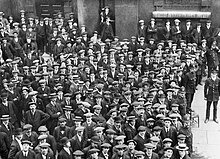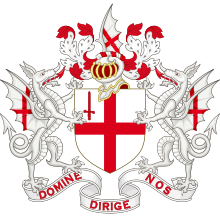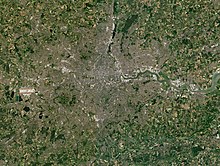by Veselina Stoynova
Copyright © 2022

London is the capital and largest city of England and the United Kingdom. It stands on the River Thames in south-east England at the head of a 50-mile (80 km) estuary down to the North Sea, and has been a major settlement for two millennia.[9] The City of London, its ancient core and financial centre, was founded by the Romans as Londinium and retains boundaries close to its medieval ones.[note 1][10] Since the 19th century,[11] “London” has also referred to the metropolis around this core, historically split between the counties of Middlesex, Essex, Surrey, Kent, and Hertfordshire,[12] which largely comprises Greater London,[13] governed by the Greater London Authority.[note 2][14] The City of Westminster, to the west of the City of London, has for centuries held the national government and parliament.
With the early 5th-century collapse of Roman rule, London ceased to be a capital and the walled city of Londinium was effectively abandoned, although Roman civilisation continued around St Martin-in-the-Fields until about 450.[46] From about 500, an Anglo-Saxon settlement known as Lundenwic developed slightly west of the old Roman city.[47] By about 680 the city had become a major port again, but there is little evidence of large-scale production. From the 820s repeated Viking assaults brought decline. Three are recorded; those in 851 and 886 succeeded, while the last, in 994, was rebuffed.[48]
The Vikings applied Danelaw over much of eastern and northern England, its boundary running roughly from London to Chester as an area of political and geographical control imposed by the Viking incursions formally agreed by the Danish warlord, Guthrum and the West Saxon king Alfred the Great in 886. The Anglo-Saxon Chronicle records that Alfred “refounded” London in 886. Archaeological research shows this involved abandonment of Lundenwic and a revival of life and trade within the old Roman walls. London then grew slowly until a dramatic increase in about 950.[49]
fter winning the Battle of Hastings, William, Duke of Normandy was crowned King of England in newly completed Westminster Abbey on Christmas Day 1066.[52] William built the Tower of London, the first of many such in England rebuilt in stone in the south-eastern corner of the city, to intimidate the inhabitants.[53] In 1097, William II began building Westminster Hall, close by the abbey of the same name. It became the basis of a new Palace of Westminster.[54][55]
In the 12th century, the institutions of central government, which had hitherto followed the royal English court around the country, grew in size and sophistication and became increasingly fixed, for most purposes at Westminster, although the royal treasury, having been moved from Winchester, came to rest in the Tower. While the City of Westminster developed into a true governmental capital, its distinct neighbour, the City of London, remained England’s largest city and principal commercial centre and flourished under its own unique administration, the Corporation of London. In 1100, its population was some 18,000; by 1300 it had grown to nearly 100,000.[56] Disaster struck in the form of the Black Death in the mid-14th century, when London lost nearly a third of its population.[57] London was the focus of the Peasants’ Revolt in 1381.[58]

Yet English maritime enterprise hardly reached beyond the seas of north-west Europe. The commercial route to Italy and the Mediterranean was normally through Antwerp and over the Alps; any ships passing through the Strait of Gibraltar to or from England were likely to be Italian or Ragusan. The reopening of the Netherlands to English shipping in January 1565 spurred a burst of commercial activity.[64] The Royal Exchange was founded.[65] Mercantilism grew and monopoly traders such as the East India Company were founded as trade expanded to the New World. London became the main North Sea port, with migrants arriving from England and abroad. The population rose from about 50,000 in 1530 to about 225,000 in 1605.[61]
In the 16th century William Shakespeare and his contemporaries lived in London at a time of hostility to the development of the theatre. By the end of the Tudor period in 1603, London was still compact. There was an assassination attempt on James I in Westminster, in the Gunpowder Plot of 5 November 1605.[66]
London was the world’s largest city from about 1831 to 1925,[86] with a population density of 325 per hectare.[87] London’s overcrowded conditions led to cholera epidemics,[88] claiming 14,000 lives in 1848, and 6,000 in 1866.[89] Rising traffic congestion led to the creation of the world’s first local urban rail network. The Metropolitan Board of Works oversaw infrastructure expansion in the capital and some surrounding counties; it was abolished in 1889 when the London County Council was created out of county areas surrounding the capital.
The city was the target of many attacks during an early terrorist campaign, the suffragette bombing and arson campaign, between 1912 and 1914, which saw historic landmarks such as Westminster Abbey and St Paul’s Cathedral bombed.[90]


London was bombed by the Germans in the First World War,[91] and during the Second World War, the Blitz and other bombings by the German Luftwaffe killed over 30,000 Londoners, destroying large tracts of housing and other buildings across the city.[92]
The administration of London is formed of two tiers: a citywide, strategic tier and a local tier. Citywide administration is coordinated by the Greater London Authority (GLA), while local administration is carried out by 33 smaller authorities.[117] The GLA consists of two elected components: the mayor of London, who has executive powers, and the London Assembly, which scrutinises the mayor’s decisions and can accept or reject the mayor’s budget proposals each year.
The headquarters of the GLA is City Hall, Southwark. The mayor since 2016 has been Sadiq Khan, the first Muslim mayor of a major Western capital.[118][119] The mayor’s statutory planning strategy is published as the London Plan, which was most recently revised in 2011.[120] The local authorities are the councils of the 32 London boroughs and the City of London Corporation.[121] They are responsible for most local services, such as local planning, schools, social services, local roads and refuse collection. Certain functions, such as waste management, are provided through joint arrangements. In 2009–2010 the combined revenue expenditure by London councils and the GLA amounted to just over £22 billion (£14.7 billion for the boroughs and £7.4 billion for the GLA).[122]

London is the seat of the Government of the United Kingdom. Many government departments, as well as the prime minister’s residence at 10 Downing Street, are based close to the Palace of Westminster, particularly along Whitehall.[128] There are 73 members of Parliament (MPs) from London, elected from local parliamentary constituencies in the national Parliament. As of December 2019, 49 are from the Labour Party, 21 are Conservatives, and three are Liberal Democrat.[129] The ministerial post of minister for London was created in 1994. The current Minister for London is Paul Scully MP.[130]
London, also known as Greater London, is one of nine regions of England and the top subdivision covering most of the city’s metropolis.[note 4] The small City of London at its core once comprised the whole settlement, but as its urban area grew, the Corporation of London resisted attempts to amalgamate the City with its suburbs, causing “London” to be defined several ways.[141]
Forty per cent of Greater London is covered by the London post town, in which ‘LONDON’ forms part of postal addresses.[142][143] The London telephone area code (020) covers a larger area, similar in size to Greater London, although some outer districts are excluded and some just outside included. The Greater London boundary has been aligned to the M25 motorway in places.[144]
Further urban expansion is now prevented by the Metropolitan Green Belt,[145] although the built-up area extends beyond the boundary in places, producing a separately defined Greater London Urban Area. Beyond this is the vast London commuter belt.[146] Greater London is split for some purposes into Inner London and Outer London,[147] and by the River Thames into North and South, with an informal central London area. The coordinates of the nominal centre of London, traditionally the original Eleanor Cross at Charing Cross near the junction of Trafalgar Square and Whitehall, are about 51°30′26″N 00°07′39″W.[148] However, the geographical centre of London on one definition is in the London Borough of Lambeth, 0.1 miles to the north-east of Lambeth North tube station.[149]

Published: Jan 26, 2022
Latest Revision: Jan 26, 2022
Ourboox Unique Identifier: OB-1270882
Copyright © 2022









